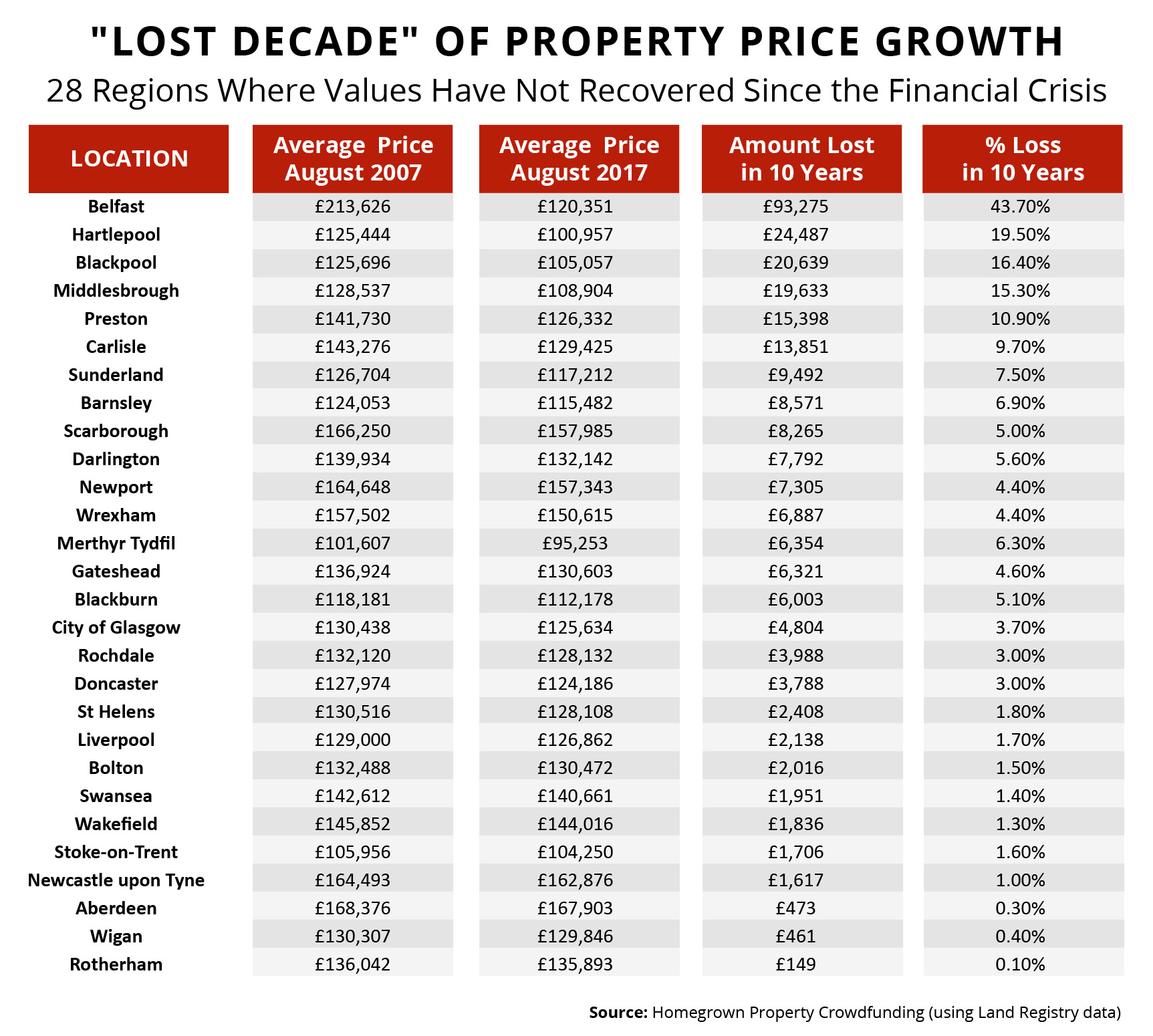November 2017 Property Investor´s Factfile
The Property Investor’s Factfile presents a range of relevant data from national / London house prices, the latest buy-to-let Limited Company (SPV) loan rates, LIBOR / SWAP rates and rentals to mortgage debt figures and information on the first-time buyer sector. Some noteworthy observations over the last month are outlined below:
Property Price Trends
- According to Halifax data, house prices picked up 4.5% in the three months to October compared to the same period a year earlier. This figure was up from the 4% annualised growth figure in September and the fastest pace since February. Although voicing concerns about increasing pressures on household finances, the Halifax did not expect the Monetary Policy Committee early November bank rate rise to be a barrier. Russell Galley from the Halifax in the FT stated: “The fact that the supply of new homes and existing properties available for sale remains low, historically low mortgage rates and high employment continue to support house prices”;
- A differing view from economic intelligence organisation Pantheon Macroeconomics highlighted the importance of being mindful of the differing house price indexation methodologies and regional variations. Chief economist Samuel Tombs, commented cautiously to the FT that: “looking ahead, the pipeline of demand is weak. In September, RICS reported that new buyer enquires fell at their fastest pace since July 2016, while sale instructions fell only marginally. Meanwhile, real wages still have further to fall and mortgage rates look set to rise by about 50 basis points over the next six months, in response to the MPC’s interest rate hike and the impending closure of the Term Funding Scheme in February. Accordingly, we expect house prices merely to flatline over the next 12 months”;
- According to Land Registry data, bearing in mind the 2-month lag for sales to appear in the public domain, UK house prices for August rose by 5% (an increase of 0.5% since July). Annual average prices in the North West were up by 6.5% (to £159,865 in August). East England prices rose by 6.4% annually, although remained relatively flat during the summer months. The East Midlands has the same rate of annual growth (6.4%), although saw a 0.3% increase between July and August to £183,762. The South Wast saw prices increase by 6.4% annually (to £188,447), up 0.6% on a monthly basis;
- Since the Brexit vote in June 2016, Land Registry data pointed to the number of year-on-year property transactions completed in the UK decreasing by 6.7% to 85,528. Over this period England saw an 11% drop in sales volumes (66,082 transactions) – whereas Scottish, Northern Irish and Welsh sales rose by 19.3% (10,473 transactions), 5% (5,106 transactions) and 1.4% (3,867 transactions) respectively;
- Transaction volumes in London saw the largest drop in the 12 months to June 2017 (dropping 20% to 6,768). Both the South-West and East of England also saw drops 14% over the same period;
- Although low sale volumes may skew the data somewhat, the Land Registry data reported a 2.62% drop in City of Westminster values and a 6.76% rise in values in the City of London between July and August. Inner [1] and Outer London [2] prices grew by 0.52% and 0.35% over this period;
- Research by housebuilding investment platform Homegrown, using Land Registry data, reported that 28 towns and cities have experienced a “lost decade” of house price growth since the financial crisis. The table below shows some noteworthy average price data –particularly how Belfast as well as northern cities including Hartlepool, Blackpool, Middlesborough, Preston and Carlisle have suffered the most:

- Other regional-specific data by Hometrack’s Cities House Price Index reported solid year-on-year growth of 6.7% in Edinburgh, 6.5% in Manchester, 5.9% in Birmingham, 5.4% in Bournemouth + Leicester, 5.3% in Glasgow and 5.1% in Bristol + Portsmouth;
- The Land Registry’s UK House Price Index (UK HPI) recently announced that it will be publishing data on property cash sales transactions (as well as on mortgage sales transactions and registered new build and resold properties). According to the most recent data, cash sales account for a surprisingly high 30% and 40% of all UK property transactions. London has the lowest proportion of cash sales (approximately 25%), whereas the South West has the highest (approximately 40%).
Rental Market Observations
- Please see The Property Investor’s Blog’s latest quartely conversation with Sam Mitchell, head of lettings at Rightmove on the portal’s quarter 3 report;
- The HomeLet Rental Index report pointed to average rents across the UK rising by 0.9% in October relative to the same period in 2016. According to the research, rents rose in 11 of the 12 regions analysed on an annual basis. However, average rents secured in October 2017 were lower than September (which has contributed to a significant slowdown in the annual rate of inflation);
- Resarch by Generation Rent entitled “Life in the Rental Market: What the Future Holds for Older Renters” estimated that the number of pensioner private renters will increase by 169% in England over the next 20 years, which would potentially cost £3.46 billion annually in Local Housing Allowance (LHA) payments. According to the research conducted in 2016, renters over the age of 60 are almost twice as likely to choose affordable rental tenure over homeownership relative to renters in their 20s.
Buy-to-Let Investing / Financing Conditions
- According to UK Finance, prior to April 1st 2016 – when there was a spike in activity as investors look to avoid the stamp duty surcharge on second properties –approximately 1 in 10 of all property transactions were for buy-to-let purposes. In August 2017, this figure dropped to 1 in 17. The industry body also indicated the increase in outstanding buy-to-let mortgages is not keeping up with the number of new mortgages being granted. Lucian Cook (@LucianCook), director of residential research at estate agent Savills, commented to the FT: “It’s the first concrete evidence that people are rationalising their portfolio or exiting the sector. It’s not an exodus or a mass offloading of buy-to-let stock, but it suggests the combined range of tax measures is causing some people to re-evaluate whether or not buy-to-let is for them.” You may be interested in our previous blog post on this topic: “The Changing Face of UK Buy-to-Let Property Investing“;
- Over the same period, the number of first-time buyers has increased – facilitated somewhat by the government’s Help to Buy scheme;
- Savills has predicted that buy-to-let property investing using a mortgage is likely to drop by 27% over the next five years. The agency attribute this to the fall the stamp duty surcharge, Prudential Regulation Authority-imposed lending constraints and the tapered effects of Section 24 mortgage interest tax relief restrictions;
- 2 year and 5 year SWAP rates increased by approximately 47% and 31%, comparing the initial working days of September and November. David Whittaker, chief executive at Mortgages for Business commented that: “come February next year I can’t believe any lenders will be running sub-4 per cent five-year fixed rates by then. I tell people that the fix-rate ship is sailing from the harbour and that they need to get on it because it’s not coming back anytime soon;”
- Bearing this in mind, this month’s property investor’s factfile points to some competitive products worth exploring prior to the inevitable rate rise. Examples include a pay rate of 2.79% fixed till the end of October 2022 with £1,950 loan fee (with a higher rate of 3.19% over the same period without a fee). The State Bank of India’s also continues to expand into this space, offering a 5-year fixed SPV mortgage with a 2.99% pay rate and a £937 loan fee. For more information and to discuss your specific borrowing circumstances please get in touch with paul.lowcock@bespokefinance.info or direct on 01133 203240.
Macro-Economic Conditions for Buy-to-Let Property Investors
- It is worth highlighting a comment made by James Roberts, Chief Economist at Knight Frank: “An increase in the base rate is often viewed with trepidation by the property industry, but this long expected move is unlikely to have a negative impact. I expect the Bank of England will follow the same strategy as the US Fed, and gently apply the brakes while giving lots of advance warning, in order to balance the competing pressures of normalising rates while not derailing growth. Consequently, I see a gradual rise ahead, partly to stockpile some future rate cuts should the MPC need to combat another downturn at a later date. Also, the Bank of England is showing some younger homeowners that rates do actually rise, given how long it has been since the country saw an increase;”
- On this latter point, UK Finance reported that there have been 2.6 million first-time buyers in the mortgage market that have never experienced a rate rise;
- According to Council of Mortgage Lenders (CML) data, the number of mortgages with 2.5% or more in arrears dropped further in the third quarter of 2017. At 88,300, the number of loans in arrears reached its lowest level since the data tracking began in 1994;
- Concerns remain over the level of credit card lending which picked up again in September, according to the Bank of England. With UK Finance also reporting that this form of unsecured borrowing through high street banks was 5.5% higher than in 2016, the figures are likely to support financial regulators ongoing concerns of artificially growing consumption levels fuelled by debt. The Bank of England base rate rise will also negatively impact those who are coming off 0% and low annual percentage rates;
- Receipts from the stamp duty surcharge (implemented in April 2016) have risen. HMRC estimations have pointed to £1.7 billion being raised in 2016-17 and over £1 billion in the six months to September.
First-Time Buyers / Help to Buy
- The Times recently reported that mortgage lenders are increasingly risk-averse when it comes to remortgaging homes purchased via Help to Buy. The equity loan scheme enables first time buyers to borrow up to 20% of the value of the property from the government. They then obtain a mortgage for 75% of the value and place a 5% deposit. However, although the first 5 years of the equity loan are interest free – after this period there is an annual fee of 1.75% + 1%. The fee rate increases annually in line with the retail price index (RPI) of inflation. So these payments will be added to the mortgage costs. As lenders have become concerned about the proportion of people’s incomes being “eaten away” by the fees, brokers have warned that homeowners could end up trapped on standard variable rates (SVRs) due to the limited options (typically after 5 years on a fixed rate). With the Bank of England believing that inflation could go up in the coming years, meaning interest rates may follow suit, the net costs (mortgage payments plus the fees) of owning a Help to Buy property could end up being unsustainably high. Some have even compared the situation to sub-prime. There may be some truth in this unless there is clear proof that lenders, when underwriting the initial mortgages, factored in the ability of buyers to cope with high SVRs and inflationary pressures on the Help to Buy equity loan fees.
Please feel free to follow us on Twitter and receive regular updates of relevance to property investors via our Facebook page. If you have not already, we would also encourage you to subscribe to our monthly e-bulletin (and receive our latest e-book and comprehensive buy-to-let financial calculator). Please click on the animation below for more information and to fill in your details in the “PLEASE LEAVE YOUR DETAILS HERE” box.
[1] The Land Registry classifies Inner London as constituting the following boroughs: Camden, City of London, Hackney, Hammersmith & Fulham, Haringey, Islington, Kensington and Chelsea, Lambeth, Lewisham, Newham, Southwark, Tower Hamlets, Wandsworth and Westminster.
[2] Informally referred to as the “donut” areas of London: Barking & Dagenham, Barnet, Bexley, Brent, Bromley, Croydon, Ealing, Enfield, Greenwich, Harrow, Havering, Hillingdon, Hounslow, Kingston upon Thames, Merton, Redbridge, Richmond on Thames, Sutton and Waltham Forest.










